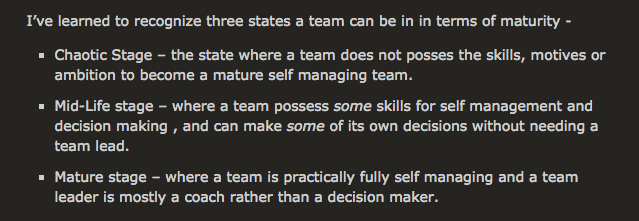and some notes on the apprenticeship model
 Apprentice At Work….I frequently hear people (managers, leaders)
Apprentice At Work….I frequently hear people (managers, leaders)
in organizations talk about “less mature” teams. Usually it is in the context of explaining why these “less mature” teams need to somehow look and operate differently than “more mature” teams. The ninjas are off solving big problems, while the white-belts are floundering in a sea of helicopter management, prescriptive work, and guardrail processes. The ninjas “grow out of Scrum” while the white-belts must do everything “by the book”.
http://5whys.com/blog/the-3-maturity-stages-of-a-software-team-and-how-scrum-fails.htmlThis really pisses me off! Why?
Because it defies how people become skilled craftspeople! Product-development is a team sport. Having mature and immature teams in an organization — and treating them differently — denies less experienced people from experiencing the dynamics of a high-functioning team as a participant. It is a sink or swim approach. Sometimes the “less mature” teams figure it out. And sometimes they flounder.
Why not hold all teams to the same standards of high performance?
This is where the apprenticeship model is effective. Students work alongside a master craftsperson (or multiple craftspeople). “Students interact constantly with the tools for success, the teachers and the beneficiaries of the work.” There’s “continuous mentoring.”
Teams should all have exposure to a master craftsperson who is doing the job (not coaching or managing) AND teaching.
Some info on apprenticeships pulled from various Wikipedia articles. Reading this gave me some ideas on how apprenticeships and associate / intern / traditional management models differ.
Apprenticeship
Sources Mentor teacher/Apprenticeship model, Educational theory of apprenticeship, and Apprenticeship .
- Combines formal training with on-the-job training
- Under supervision of master craftsperson. Works “side by side” with an expert
- Working with an expert in order to perform at an acceptable level
- Not learning skills at a basic level but rather at a level that is accepted in the specific industry
- Apprentice receives continuous mentoring. Mentoring not considered a separate activity
- Master demonstrates correct way of completing a task
- Master who selects the assignment which are appropriate for the apprentice. Instruction is adapted to the needs of the apprentice
- Reflective imitation, imitative reconstruction and selective reconstruction
- Offers “structured high-value learning and transferable skills and knowledge”
- Learning through interactions between individuals, cultural tools and social communities
- Professional identity is developed through the process of mastering new skills
- Novice advances from “peripheral legitimate participation” to “full participation”
- Observe performance of an activity by experienced members
- Students become immersed in “authentic activities”. Active, social, and authentic
- Learn practical, tacit strategies for achieving goals
- Students interact constantly with the tools for success, the teachers and the beneficiaries of the work
